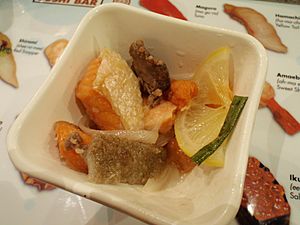Nanbanzuke facts for kids
Nanbanzuke (pronounced Nahn-bahn-zoo-keh) is a tasty Japanese fish dish. Its name means "southern barbarian pickle" or "marinade." This interesting name comes from the Nanban trade, which was when European traders, especially the Portuguese, came to Japan in the 16th century. The Japanese called these newcomers "southern barbarians."
To make Nanbanzuke, fish like Japanese jack mackerel or wakasagi smelt is first fried until it's crispy. Then, the fried fish is soaked in a special marinade. This marinade is a mix of vinegar, sugar, carrots, and chili peppers. The dish is quite similar to a Spanish and Portuguese dish called escabeche. It's thought that the Portuguese brought the idea for this type of marinated fish to Japan many centuries ago.
What is Nanbanzuke?
Nanbanzuke is a popular Japanese dish that features fried fish marinated in a sweet and sour sauce. It can be served hot or cold. This makes it a great dish for different seasons. The marinade gives the fish a unique tangy flavor. It also helps to keep the fish fresh.
How Nanbanzuke is Made
Making Nanbanzuke involves a few simple steps. First, fresh fish is cut into bite-sized pieces. These pieces are often lightly coated in flour or potato starch. This helps them get crispy when fried. The fish is then deep-fried until it's golden brown and cooked through.
While the fish is frying, the special marinade is prepared. This sauce usually includes vinegar, soy sauce, sugar, and a little bit of chili pepper for a mild kick. Thinly sliced vegetables, like carrots and onions, are often added to the marinade. Sometimes, other vegetables like bell peppers are also included.
Once the fish is fried, it is immediately placed into the warm marinade. The fish soaks up all the delicious flavors from the sauce and vegetables. It's often left to marinate for at least an hour. Many people prefer to let it sit overnight for the best taste.
History of Nanbanzuke
The story of Nanbanzuke goes back to the 16th century. This was a time when European traders, especially from Portugal, arrived in Japan. They brought new ideas, goods, and even cooking methods. The Japanese called these traders "Nanban," meaning "southern barbarians," because they came from the south.
One of the cooking styles the Portuguese brought was marinating fried fish in vinegar. This was a way to preserve fish. It also added a lot of flavor. The Japanese adapted this idea and created their own version, which became Nanbanzuke. It shows how different cultures can influence each other's food.
See also
 In Spanish: Nanbanzuke para niños
In Spanish: Nanbanzuke para niños



